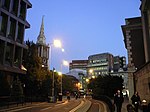Tulip (tower)
Proposed buildings and structures in London
The Tulip was a 305-metre observation tower proposed to be constructed on 20 Bury Street in the City of London. The Tulip is a proposal by Brazilian billionaire Jacob Safra, of the Safra Group, the owner of the adjacent 30 St Mary Axe, informally known as the Gherkin. The proposal was rejected on 11 November 2021.
Excerpt from the Wikipedia article Tulip (tower) (License: CC BY-SA 3.0, Authors).Tulip (tower)
Saint Mary Axe, City of London
Geographical coordinates (GPS) Address Website Nearby Places Show on map
Geographical coordinates (GPS)
| Latitude | Longitude |
|---|---|
| N 51.5145 ° | E -0.08 ° |
Address
30 St Mary Axe (Swiss Re Building)
Saint Mary Axe 30
EC3A 8EP City of London (Lime Street)
England, United Kingdom
Open on Google Maps





